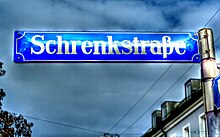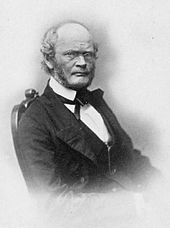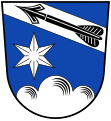Schrenck from Notzing
Schrenck von Notzing (also Schrenk von Notzing or Schrenck-Notzing , often just Schrenck ) is the name of a Munich patrician family . The family, some of which still exist today, is one of the oldest and most influential families in the Munich City Council .
history

origin
The Schrenck have the same coat of arms as the Ridler and Ligsalz families, who also come from the Munich patriciate , but with different crests . However, it is not clear whether they also have a common origin. According to tradition, the coat of arms cooperative is said to have come from an old Schrenck who married his two daughters to a Ridler and a league salt.
The family is mentioned for the first time in 1269. The uninterrupted family line begins with Perhtolt Schrench (Berchtold Schrenck), who is mentioned in documents from 1295 to 1297. He was a citizen, merchant and member of the Munich City Council. In 1308 the Drächsel and the Schrenck of the customs were prescribed at the upper and lower gate of Munich.
Spread and lines
The family founded two lines early on, named after their headquarters in Notzing and Egmating . After Kneschke , the progenitor Berchtold Schrenck was the first owner of the Notzing parent company. He is said to have been a son of Triphon Schrenck, court servant of Landgrave Eckhart of Thuringia. Berchtold married Thekla, a daughter of the old Munich patrician family of the Khrai. Nicolaus, a descendant of this marriage, acquired the Hofmark Egmating in 1290 by marrying Gertraut Impler , who also came from an old noble family in Munich . According to the Genealogical Handbook of the Nobility , Notzing came into the possession of the family in 1380.
Lorenz (I.) Schrenck was field captain in the battle of Alling in 1422 . His son Lorenz (II.) Was field captain of the Poles when they stormed Marienburg in 1457 in East Prussia . During the siege there was an argument between him and the Polish gentleman Nikolaus Zarnotzky. This refused him the duel because he did not know whether Lorenz was of noble descent. Duke Albrecht III. Lorenz then confirmed that he was a Bavarian knight and heraldic comrade and descended from four respectable people.
The Schrenck belonged to the city council for over 300 years and provided several city treasurers . They achieved wealth primarily through long-distance trade and shares in the Tyrolean mining industry. This is how the family became prosperous. Bartholomäus Schrenck (* 1450, † 1519) was the city's representative and councilor to Duke Albrecht IV of Bavaria . As such, he was one of the co-signers of the Primogeniture Act in 1506 on the indivisibility of the Duchy of Bavaria . He was also a member of the guardianship of the underage Duke Wilhelm IV of Bavaria .
With the entry into the ducal Bavarian service during the 16th century, the Schrenk succeeded in the transition from the urban bourgeoisie to the landed gentry, which ended in 1625. Already in 1408 Michael Schrenck († 1429), the Munich Civil Rights had given up and was as Country aces , because of the inherited property to Notzing, a member of the knighthood in Bavaria-Landshut . In the first half of the 16th century the family lost the Notzing parent company. Nevertheless, in 1575 relatives received confirmation of imperial nobility as Schrenck von Notzing . Around 1500 the brothers Bartholomäus († 1519), Hieronymus († 1510) and Johann divided the family into three tribes. The family came to Saxony through the latter . Johann got to know the Saxon dukes Ernst and Albrecht in Innsbruck , who appointed him to their council . The tribe died out in 1630.
During the 17th and 18th centuries, branches also settled in the Upper Palatinate and the Bavarian Forest . From there a branch came to the Kingdom of Bohemia . In the middle of the 19th century there were still three lines, one Bavarian, one Bohemian and one North German.
Bavarian line
The Bavarian treasurer Ignaz Freiherr Schrenck von Notzing (* 1721; † 1774) came from the Bavarian line . A year before his death he married Maria Barbara Weissmann von Weissenstein. His son Sebastian Freiherr Schrenck von Notzing (* 1774; † 1848) became royal Bavarian treasurer, minister of justice, and imperial and state council. From his marriage to Leopoldine Freiin von Asch (* 1778; † 1840) came Anton Freiherr Schrenck von Notzing (* 1800), lord of the gentlemen Gutmaning, Birnbrunn, Hüllstett and Thann. He became a royal Bavarian appellate judge . Anton married Johanna Freiin von Asch (* 1809; † 1842) in 1833 and left three sons in addition to a daughter. Two sons, barons Leopold (* 1835) and Eduard (* 1838), entered royal Bavarian military service. Her uncle, the younger brother of Freiherr Anton, Carl Freiherr Schrenck von Notzing (* 1806, † 1884), Herr zu Wetterfeld, became royal Bavarian chamberlain, former Bundestag envoy and later State Councilor as well as Minister of the Royal House, Foreign Affairs, Commerce and Chairman in the Council of Ministers. From 1868 he was a lifelong Reichsrat and from 1871 until his death the second president of the First Chamber . He married Augusta Freiin von Frankenstein in 1845 and had two daughters.
Austrian line
The founder of the Austrian line was Johann Christoph Adam Freiherr Schrenck von Notzing (* 1700; † 1764). He became a curb-Bavarian treasurer and married Maria Antonia Countess Henckel von Donnersmarck . Their son Franz Seraph Freiherr Schrenck von Notzing (* 1747, † 1810) was Lord of Zbenice in Bohemia, imperial chamberlain and major . Joseph Freiherr Schrenck von Notzing, son of Freiherr Franz from his second marriage, married in 1791 with Theresia Cajetane Freiin von Aßfeld and Widrzi ( Asfeld z Vydří ; 1765–1805), was an imperial treasurer, district president of Budweis and an honorary citizen of several Bohemian cities. Of his brothers, Ignaz (* 1800) became Imperial Chamberlain and Court Secretary of the General Court Chamber and Anton (* 1806) became Imperial Lieutenant Colonel . Both were able to continue the tribe with sons and daughters. Alois Joseph Schrenck von Notzing (* 1802, † 1849), who was initially Auxiliary Bishop of Olomouc and later Archbishop of Prague, also came from this line . His nephew Ernst Freiherr Schrenck von Notzing (* 1845, † 1909) was the imperial major general . The line became extinct in the 20th century.
North German line
The north German third line goes back to Franz Xaver Freiherr Schrenck von Notzing. His father Johann Gottlieb (* 1685; † 1748) married a distant cousin. The family fell into poverty as a result of an inheritance dispute and the chaos of war during the War of the Austrian Succession in the Upper Palatinate . Franz Xaver entered the Theatine order and taught philosophy in Munich. After a change of denomination, he fled to Holland , where he settled as a doctor near Groningen . In 1745 he married Catharina Wallburger von Cönnern. All later relatives in Hanover and Oldenburg descend from him . His son Philibert Freiherr Schrenck von Notzing (* 1750, † 1792) became the landowner of Hoogezand . He was married twice, his first marriage from 1775 to Gepke Ludolphs († 1779) and his second marriage from 1784 to Hillegina Hoving († 1798). From the first marriage came son Franz Xaver Freiherr Schrenck von Notzing (* 1776; † 1860) and from the second marriage also a son Philipp Freiherr Schrenck von Notzing (* 1786; † 1851), both of whom moved to East Friesland . The former became the Hanoverian Rendant of Aurich and married Helena Jacobs in 1800 (* 1778; † 1853). The marriage resulted in numerous descendants who could continue the tribe. His son Albert Philibert Schrenck von Notzing (* 1800; † 1877) became the Grand Duke of Oldenburg Upper Chamber Council , land survey director and member of the grand ducal land registry. Under his leadership, 3000 land maps and parish maps, a topographical map series and a general map were created. His son Wilhelm Freiherr Schrenk von Notzing (* 1828; † 1892) became Lord Mayor of Oldenburg . Albert's younger brother Franz Freiherr Schrenck von Notzing (* 1806) became a royal Prussian tax officer in the Rhine Province . The older son Franz von Schrenck-Notzing (1824–1905) was Rittmeister whose son Albert emerged as a medic. From the marriage with the industrialist daughter Gabriele Siegle (1872–1953) came Leopold (1894–1970), from 1929 to 1945 member of the supervisory board of IG Farbenindustrie AG, and Gustav (1896–1943) Prussian cavalry master, as well as father of the journalist Caspar von Schrenck -Notzing .
Status survey
Bartholomaeus Schrenckh von Notzing, alderman and Kastner of Munich as well as the ducal Bavarian council, received an imperial nobility confirmation in Vienna on November 22, 1575 with a coat of arms of the expired Wilprecht family.
His sons Jakob , archducal secretary and treasurer, Carl Alexander, ducal Bavarian nurse to Eckmühl, Octavian Augustus, ducal Bavarian and prince-bishop of Regensburg chancellor and fiefdom, Friedrich, archducal court secretary and Bartlme, the Schrenckhen of Notzing, received on August 24th, 1581 at Innsbruck of Archduke Ferdinand a Tyrolean nobility confirmation or extension of a coat of arms improvement and on the same day also Caspar Schrenckh to Egmating, ducal Bavarian advice and his sons Hanns, ducal Bavarian advice and sub equerry , and Christopher, a member of the inner council in Munich, and the brothers Ludwig , Stiftsvikar zu Freising , Wilhelm, Landgrave Leuchtenberger Rat zu Pfreimd , Urban, ducal Bavarian Kastner zu Pfaffenhofen, Albrecht, Georg and Ferdinand, the Schrenckhen von Notzing, sons of the deceased ducal Bavarian Kastner Hieronymus Schrenckh, as well as Philipp, Wolf and Ezechil, the Schrenckhen from N otzing in the country of Meissen.
Johann Schrenk, ducal Bavarian rentmaster , received the ducal Bavarian noblemen's freedom on October 21, 1595 and Carl Alexander Schrenk on Prandstetten on January 16, 1607.
Older line
On July 8, 1685, Ladislaus Schrenkh von Notzing zu Egmating received an electoral Bavarian permission to use the predicate of .
Maximilian Christian von Schrenckh was raised to the electoral Bavarian baron status on January 12, 1688 , as was Alexander Ignaz Schrenkh von Notzing auf Grueb, electoral Bavarian council, on April 14, 1694 in Munich and the aforementioned Ladislaus von Schrenk on October 20, 1694. One Johann Rudolph Schrenck von Notzing received an electoral Bavarian tender as baron on August 28, 1700. Franz Anton Max Schrenkh von Egmating zu Inkhofen received the Bavarian electoral baron on March 30, 1703 and Johann Joseph von Schrenck zu Adlshausen received an electoral Bavarian on March 24, 1723 Tender as baron.
Franz Freiherr von Schrenck of Notzing on Zbenicz, imperial chamberlain and Major, received on February 6, 1796 Vienna, the Czech Inkolat in Mr. Booth .
Younger line
Gottlieb von Schrenk auf Notzing zu Gutmaning and Birnbrunn was elevated to the status of a Bavarian baron on September 22, 1719 in Munich.
From the older branch of the younger line, Albert Freiherr Schrenck von Notzing, Grand Ducal Oldenburg Chamberlain , received Oldenburg recognition of the baron on February 23, 1834 . His brother Franz Freiherr von Schrenck, royal Prussian tax officer, received Prussian recognition of the baron status on January 27, 1841 and an entry in the nobility register of the Prussian Rhine Province by ministerial rescript . A Prussian name determination as Freiherr von Schrenck von Notzing took place for Albert's son Franz Freiherr Schrenck von Notzing, royal Prussian major at disposition , on August 25, 1882 by heraldry rescript .
From the younger branch of the younger line, Sebastian Freiherr von Schrenk auf Gutmaning, royal Bavarian chamberlain and higher appellate judge in Munich, together with his cousin received an entry in the baron class of nobility in the Kingdom of Bavaria on August 16, 1813.
coat of arms

Family coat of arms
The family coat of arms shows a silver slanting bar in red with a slanted black arrow on it. On the helmet is an open or closed flight that repeats the shield sign. The helmet covers are red-silver.
Improvement of the coat of arms from 1575 and 1581
Through an improvement in the coat of arms, awarded in 1575 by Emperor Maximilian II , the coat of arms of the extinct patrician family Wilprecht (also Wilbrecht) was added. The coat of arms was now quartered , 1 and 4 the family coat of arms, 2 and 3 in silver three (2: 1) red lion heads with a chipped red tongue. In 1581 the second helmet with red and silver helmet covers and a growing, crowned red lion as a helmet ornament was added.
Local and municipal coats of arms
The arrow from the coat of arms of the Schrenck von Notzing family still appears in some Bavarian local coats of arms.
Coat of arms of the community of Höhenkirchen-Siegertsbrunn
Coat of arms of the Mariaposching community
Name bearer
- Albert von Schrenck-Notzing (* 1862, † 1929), German physician and parapsychologist
- Albert Philibert Schrenck von Notzing (* 1800; † 1877), German geodesist and senior chamber councilor
- Alexander von Schrenk (* 1816; † 1876), German-Russian naturalist
- Alexander von Schrenck-Notzing (* 1965), since 2012 Chairman of the Board of Trustees of the Conservative Education and Research Foundation , founding member of Die Republikaner in 1983 and of the Republican University Association in 1989
- Alois Joseph Schrenck von Notzing (* 1802; † 1849), auxiliary bishop in Olomouc and archbishop of Prague
- Caspar von Schrenck-Notzing (* 1927, † 2009), German right-wing conservative publicist, grandson of Albert Freiherr von Schrenck-Notzing
- Jakob Schrenck von Notzing (* 1539; † 1612), Bavarian nobleman and historian, secret secretary of Duke Ferdinand II of Tyrol
- Karl Schrenck von Notzing (* 1659; † 1704), abbot of the Benedictine monastery of St. Peter in Salzburg and university professor
- Karl von Schrenck von Notzing (* 1806; † 1884), Bavarian politician
- Leopold von Schrenck (* 1826; † 1894), German-Russian zoologist, geographer and ethnographer
- Sebastian von Schrenck (* 1774; † 1848), Bavarian Higher Appeal Judge and Minister of Justice
- Wilhelm von Schrenck (* 1828; † 1892), Lord Mayor of Oldenburg
souvenir

The Bavarian state capital Munich named an approximately 250-meter-long connecting road between Landsbergerstrasse and Westendstrasse in the Schwanthalerhöhe district after the noble family. In it is the Catholic Church of St. Benedict . The tram stop at the north end (corner of Landsbergerstrasse / Schrenkstrasse) for lines 18 and 19 is also called Schrenkstrasse .
See also
Individual evidence
- ↑ a b Otto Hupp : Munich Calendar 1918. Page 29
- ↑ Main State Archives Munich , document from the Scheyern Monastery , No. 30
- ↑ a b c d e f g h i j k Genealogisches Handbuch des Adels , Adelslexikon Volume XIII, Volume 128 of the complete series, pages 96–98.
- ↑ a b c d e New General German Adels Lexicon Volume 8, pages 339–342.
- ^ Helmut Stahleder, Schrenck, Adelsfamilie, published on August 1, 2012; in: Historisches Lexikon Bayerns, URL: < http://www.historisches-lexikon-bayerns.de/Lexikon/Schrenck ( page no longer available , search in web archives ) Info: The link was automatically marked as defective. Please check the link according to the instructions and then remove this notice. , Noble family> (19.01.2017)
- ↑ a b Niklas Schrenck von Notzing: Schrenck von Notzing. In: New German Biography (NDB). Volume 23, Duncker & Humblot, Berlin 2007, ISBN 978-3-428-11204-3 , pp. 542-544 ( digitized version ).
- ↑ Shamefully failed . In: Der Spiegel . No. 19 , 1990 ( online - 7 May 1990 ).
- ↑ Munich street names and their meaning (accessed April 23, 2012)
literature
- Ernst Heinrich Kneschke : New general German nobility lexicon . Volume 8, Friedrich Voigt's Buchhandlung, Leipzig 1868, pages 339–342. ( Digitized version )
- Constantin von Wurzbach : Schrenck on Notzing, the barons, genealogy . In: Biographisches Lexikon des Kaiserthums Oesterreich . 31st part. Imperial-Royal Court and State Printing Office, Vienna 1876, p. 299 f. ( Digitized version ).
- Constantin von Wurzbach : Schrenck on Notzing, coat of arms . In: Biographisches Lexikon des Kaiserthums Oesterreich . 31st part. Kaiserlich-Königliche Hof- und Staatsdruckerei, Vienna 1876, p. 301 ( digitized version ).
- Karl Theodor von Heigel : Schrenck, Munich councilor and merchant family . In: Allgemeine Deutsche Biographie (ADB). Volume 32, Duncker & Humblot, Leipzig 1891, pp. 485-488.
- Otto Hupp : Munich Calendar 1918 . Book u. Art Print AG, Munich / Regensburg 1918.
- Genealogisches Handbuch des Adels , Adelslexikon Volume XIII, Volume 128 of the complete series, pages 96-98; CA Starke Verlag , Limburg (Lahn) 2002, ISSN 0435-2408
- Niklas Schrenck von Notzing: Schrenck von Notzing. In: New German Biography (NDB). Volume 23, Duncker & Humblot, Berlin 2007, ISBN 978-3-428-11204-3 , pp. 542-544 ( digitized version ).
Web links
- Helmut Stahleder: Schrenck, noble family . In: Historical Lexicon of Bavaria
- Entry about Schrenck von Notzing in the central database of bequests










